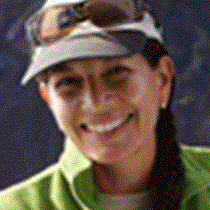South Plazas and Santa Fe
Today was our lucky day. We awoke in the morning to a gorgeous landscape — a cactus forest teeming with yellowish land iguanas (Conolophus subcristatus). They’re found on only a few islands, and we watched them eating some spiny cactus pieces. Hundreds of iguana burrows in the landscape were evidence that these creatures are cold blooded animals. They use the burrows to warm up at night and seek shade from the sun during the hot season.
Swallow-tailed gulls were nearby taking care of their hungry young and protecting them from the occasional and furtive attacks of frigate birds trying to steel food or even a young baby.
At the sea lion “bachelor’s point” the rocks look like marble. Over hundreds of years they’ve been polished to a fine shine by the massive male sea lions rubbing their bodies against them in the search of the best position for a long nap. On the other side of the island young babies spent their days exploring the new world open to their eyes.
Back at the ship it was time for a quick swim before watching a very interesting behind-the-scenes video about National Geographic Islander.
After a fantastic Peruvian buffet lunch, we enjoyed making necklaces and bracelets using the paper beads made with recyclable paper in town. This project is now run by the Lindblad Expeditions-National Geographic Joint Fund and supports the local community as well as recycling waste, and important consideration on the islands.
Soon after, it was time to get prepare to go kayaking near Santa Fe Island. We had beautiful scenery for the outing —cliffs, massive rocks, cactus and a very calm sea.
After kayaking we went back to the ship and prepared to explore the highlands of Santa Fe. Landing at the beach patrolled by at least ten white-tipped reef sharks was quite interesting, but no less than the dozens of sea lions on the beach, napping, feeding and enjoying the soft while coral sand.
The rocky inland trail led us to see our first pale brownish-green land iguana (Conolophus pallidus), a species found only in Galápagos. We also saw rice rats, endemic species that feed on fruits and seeds, and the always skittish Galápagos snakes, and the majestic Galápagos hawks that at the moment are the subject of a study by a field team of the Universidad Católica del Ecuador and the University of Missouri. We had a chance to chat with the researchers who responded to our curiosity and answered every question we had.
On the way back to the ship we saw a quiet but inquisitive short-eared owl waiting for us alongside the trail, as if posing for the pictures like an important member of a royal family.
Leaving behind Santa Fe and its inhabitants, we simply enjoyed been part of it, hearing the sounds of nature and the beauty of life.




